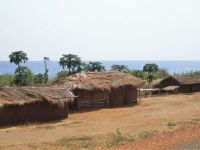Yaoundé. La métropole face à son arrière-pays
 Ouvrage collectif coordonné par René Joly Assako Assako.
Ouvrage collectif coordonné par René Joly Assako Assako.
Édition Dianoïa, 2011.
Dans les pays développés du nord et plus encore dans les pays en développement des suds, les métropoles ont, généralement, un comportement de phagocytose et de polarisation vis-à-vis de leur arrière-pays. Elles exercent sur celui-ci une ponction intense des ressources de toute nature pour répondre à la forte demande induite par leur croissance continue. L’espace rural environnant, sous le double effet de périurbanisation et de rurbanisation, subit par connséquent de profondes mutations qui font craindre la fin sans transition des campagnes.
Yaoundé, capitale du Cameroun, suit un schéma qui mérite d’être qualifié de curiosité urbanistique. Au lieu de créer un vide autour d'elle, cette métropole à l'échelle africaine impulse plutôt le Ie développernent de ses villes satellites en pôles socioéconomiques locaux, malgré, il est vrai, la survivance d’espaces de retranchement ou de résistance à la mouvance clairement observée.
Ne pouvant totalement déroger à la règle, Yaoundé fait tout de même porter le poids de son rang de métropole à son arrière-pays. Il en est ainsi de la réalisation ou de la délocalisation de certains équipements qui ont des conséquences notamment sanitaires au niveau de l'arrière-pays proche ou lointain.
Le présent ouvrage est un précieux outil d’analyse et de compréhension du fonctionnement des grandes villes d’Afrique. Il sera une bonne source d'inspiration pour les chercheurs confirmés du domaine, autant qu’il guidera les pas des ieunes chercheurs et étudiants engagés dans la géographie des villes tropicales des pays en développement. Aussi s’appuie-t-il sur un solide travail de terrain qui a permis de parvenir à des résultats qu’on n’aurait pas pu obtenir autrement.
Innovations et mutations agricoles au Gabon

de Noël Ovono Edzang.
Éditions universitaires européennes, 2011. 328p.
Pays pétrolier, minier et forestier, le Gabon est l'un des pays africains où l'agriculture est très peu développée. L'objet de ce travail de recherches est d'identifier et de localiser, les nouvelles activités agricoles dans ce pays. Le développement de l'hévéaculture dans le Woleu-Ntem et l'émergence de l'agriculture urbaine et périurbaine dans la province de l'Estuaire ont été étudiés. Les facteurs et conditions de l'innovation, les transformations agricoles dans le Woleu-Ntem et le développement du maraîchage à l'intérieur et à la périphérie de Libreville ont été abordés ainsi que les questions foncières et la dépendance alimentaire du Gabon.
Geoecology in the Tropics with a Database on Micromorphology and Geomorphology
 by Hanna Bremer.
by Hanna Bremer.
Zeitschrift für Geomorphology N.F., 2010, Vol. 54, Suppl. Issue 1. 337 p., 132 fig., 91 tab. Paperback.
The "Cologne Regolith Database" (CRD) is the result of more than twenty years research in the tropics by staff members and students of the Geographical Institute of the University of Cologne (Germany) under the direction of Prof. Hanna Bremer. It contains results for more than 1200 samples studied in detail in the field and the laboratory. More than 30 parameters, each comprising several components, were thoroughly studied and statistically evaluated. The final step of such large research programme is of course its synthesis, and this is exactly what we find in this book.
Weathering being the basis of all geomorphological processes, a dominant part of the book is devoted to this subject. Different aspects of weathering are discussed, based largely on mineralogical and micromorphological studies. After the characterisation of saprolites, their transformation to other regolith material, including soils, is discussed. This is followed by the analysis of erosional and morphogenetic processes on different rock types in different environments. Throughout the book the influence of parent material and enviromnental conditions is emphasised, without forgetting the role of the palaeoenviromnent.
A wealth of precise data is given. Therefore it is regrettable that for some concepts no precise definitions are given. For instance, the concepts of regolith versus saprolite and soil are not clearly delimited, and micromorphological descriptions do not use standard terminology. Also the identification of soils is not based on an international system.
The book contains many diagrams and instructive colour pictures of profiles and thin sections. (for the
latter images between crossed polarisers are shown) with extensive and instructive captions. The numerical system used for titles and subtitles (e.g. 10.5.3. Planar processes followed by 10.5.3.1. Field observation) makes the structure of the text very clear and cross referencing efficient.
"Geoecology in the Tropics" contains a large amount of qualitatively excellent data and new insights
concerning the genesis of tropical regoliths and their relationship with geomorphology. Extensive citation of less well known local publications opens new horizons, and compensates a rather limited referencing to international literature. Although this is not a traditional book on soils, it is most interesting and innovative with regard to soil formation in the tropics because of its global approach, and therefore highly recommended for pedologists, geomorphologists and ecologists working in tropical zones. Also for palaeopedologists and palaeoecologists working in temperate zones it is a most useful document.
G. Stoops
More information : www.schweizerbart.de










